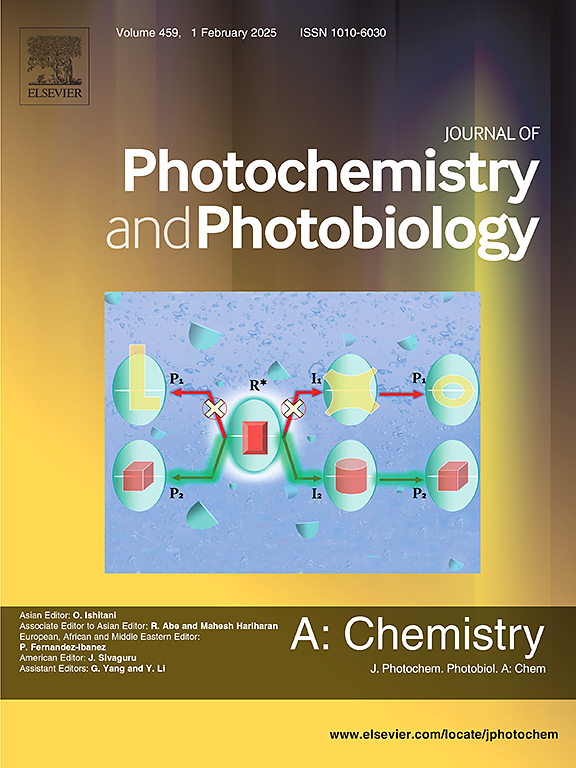How do different phase structures of crystalline e-TiO2 nanomaterials affect the UV resistance of unsaturated polyester Resins?
IF 4.7
3区 化学
Q2 CHEMISTRY, PHYSICAL
Journal of Photochemistry and Photobiology A-chemistry
Pub Date : 2025-06-06
DOI:10.1016/j.jphotochem.2025.116555
引用次数: 0
Abstract
Unsaturated polyester resins (UPRs) are widely used in construction and composite materials due to their good mechanical properties and processability. However, their susceptibility to ultraviolet (UV) resistance limits their long-term outdoor use. To improve UV resistance, electrochemically synthesized TiO2 nanoparticles (e-TiO2) with strong UV absorption were incorporated into the UPR to enhance UV resistance. A critical challenge lies in balancing UV shielding effectiveness with the photocatalytic activity of e-TiO2, which can accelerate polymer degradation. This study investigates the influence of three crystalline phases of e-TiO2 anatase, brookite and rutile on the UV protection performance of UPR/e-TiO2 nanocomposites. The results showed that UPR reinforced with anatase, brookite and rutile achieved UV protection improvements of 72.2%, 49.2%, and 33.7%, respectively, compared to pure UPR. Anatase phase e-TiO2 demonstrated the best performance, attributed to its fine particle size and moderate photocatalytic activity, providing a more favorable balance between protection and material stability. These nanocomposites were successfully applied in engineered quartz stone production, showing enhanced UV durability, demonstrating strong potential for large-scale outdoor applications. These findings highlight the importance of the e-TiO2 crystalline phase and particle properties in optimizing UV protection and open up new possibilities for durable, weather resistant UPR based materials in industrial scale applications.

不同相结构的e-TiO2纳米材料如何影响不饱和聚酯树脂的抗紫外线性能?
不饱和聚酯树脂因其良好的力学性能和可加工性在建筑材料和复合材料中得到了广泛的应用。然而,它们对紫外线(UV)抗性的敏感性限制了它们在室外的长期使用。为了提高紫外抵抗能力,将电化学合成的具有强紫外吸收能力的TiO2纳米粒子(e-TiO2)掺入UPR中,增强其抗紫外能力。一个关键的挑战在于平衡e-TiO2的紫外线屏蔽效果和光催化活性,这可以加速聚合物的降解。本研究考察了e-TiO2锐钛矿、板钛矿和金红石三种晶相对UPR/e-TiO2纳米复合材料防紫外线性能的影响。结果表明,与纯UPR相比,添加锐钛矿、蓝铜矿和金红石的UPR防紫外线性能分别提高72.2%、49.2%和33.7%。锐钛矿相e-TiO2表现出最好的性能,由于其粒度细,光催化活性适中,在保护和材料稳定性之间提供了更有利的平衡。这些纳米复合材料成功应用于工程石英石生产,显示出增强的紫外线耐久性,显示出大规模户外应用的强大潜力。这些发现突出了e-TiO2晶体相和颗粒特性在优化紫外线防护方面的重要性,并为工业规模应用中耐用、耐气候的UPR基材料开辟了新的可能性。
本文章由计算机程序翻译,如有差异,请以英文原文为准。
求助全文
约1分钟内获得全文
求助全文
来源期刊
CiteScore
7.90
自引率
7.00%
发文量
580
审稿时长
48 days
期刊介绍:
JPPA publishes the results of fundamental studies on all aspects of chemical phenomena induced by interactions between light and molecules/matter of all kinds.
All systems capable of being described at the molecular or integrated multimolecular level are appropriate for the journal. This includes all molecular chemical species as well as biomolecular, supramolecular, polymer and other macromolecular systems, as well as solid state photochemistry. In addition, the journal publishes studies of semiconductor and other photoactive organic and inorganic materials, photocatalysis (organic, inorganic, supramolecular and superconductor).
The scope includes condensed and gas phase photochemistry, as well as synchrotron radiation chemistry. A broad range of processes and techniques in photochemistry are covered such as light induced energy, electron and proton transfer; nonlinear photochemical behavior; mechanistic investigation of photochemical reactions and identification of the products of photochemical reactions; quantum yield determinations and measurements of rate constants for primary and secondary photochemical processes; steady-state and time-resolved emission, ultrafast spectroscopic methods, single molecule spectroscopy, time resolved X-ray diffraction, luminescence microscopy, and scattering spectroscopy applied to photochemistry. Papers in emerging and applied areas such as luminescent sensors, electroluminescence, solar energy conversion, atmospheric photochemistry, environmental remediation, and related photocatalytic chemistry are also welcome.

 求助内容:
求助内容: 应助结果提醒方式:
应助结果提醒方式:


